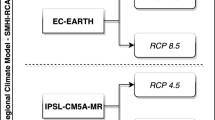Abstract
Stochastic modelling provides a tool for exploring the full implications of the statistical behavior of historical records and can be used to predict the changing probabilities that events of various magnitudes will occur for different climatic change scenarios. Two simulation models are presented, one for daily air temperature, and the other for daily precipitation. The simulation procedures are: (1) extract salient parameter values from historical records; (2) simulate long sequences of data using the stochastic models, with or without a climatic change scenario as provided by a general circulation model; and (3) using the simulated data as inputs, derive the probability distributions of other variables based on known deterministic or probabilistic relationships between the input and the predicted variables.
Given a doubling of carbon dioxide concentration in the atmosphere, the climatic models produce varying degrees of temperature and precipitation changes. Examples of application, including the derivation of snowfall and riverice data using simulated temperature and precipitation, illustrate that stochastic modelling offers a suitable approach to quantify the possible hydrologic impacts of climatic change.
Similar content being viewed by others
References
Allen, W. T. R.: 1977, Freeze-up, Break-up and Ice Thickness in Canada, Atmospheric Environment Service, Fisheries and Environment Canada, Publication CL1-1-77, 185 pp.
Billelo, M. A.: 1980, Maximum Thickness and Subsequent Decay of Lake, River and Fast Sea Ice in Canada and Alaska, U.S. Army, Cold Regions Research and Engineering Laboratory Report 80-6, 160 pp.
Conrad, V. and Pollak, L. W.: 1950, Methods in Climatology, Harvard University Press, Cambridge, 459 pp.
Feyerherm, A. M. and Bark, L. D.: 1967, ‘Goodness of Fit of a Markov Chain Model for Sequences of Wet and Dry Days’, Journal of Applied Meteorology 6, 770–773.
Gabriel, K. R. and Neumann, J.: 1957, ‘On the Distribution of Weather Cycles by Length’, Quarterly Journal of Royal Meteorological Society 83, 375–380.
Green, J. R.: 1964, ‘A Model for Rainfall Occurrence’, Journal of Royal Statistical Society, Ser. B 26, 345–353.
Haan, C. T.: 1977, Statistical Methods in Hydrology, Iowa State University Press, Ames, 378 pp.
Hillier, F. S. and Lieberman, G. J.: 1967, Introduction to Operations Research, Holden-Day, San Francisco, 639 pp.
Ison, N. T., Feyerherm, A. M., and Bark, L. D.: 1971, ‘Wet Period Precipitation and the Gamma Distribution’, Journal of Applied Meteorology 10, 658–665.
Mearns, L. O., Katz, R. W., and Schneider, S. H.: 1984, ‘Extreme High-Temperature Events: Changes in Their Probabilities with Changes in Mean Temperature’, Journal of Climatology and Applied Meteorology 23, 1601–1613.
Moss, M. E. and Tasker, G. D.: 1987, ‘The Role of Stochastic Hydrology in Dealing with Climatic Variability’, International Association of Hydrological Sciences Publication 168, 201–207.
Naylor, T. H., Balintfy, J. L., Burdick, D. S., and Chu, K.: 1966, Computer Simulation Techniques, John Wiley and sons, New York, 352 pp.
Petterssen, S.: 1969, Introduction to Meteorology, McGraw-Hill, New York, 333 pp.
Press, W. H., Flannery, B. P., Teukolsky, S. A., and Vetterling, W. T: 1986, Numerical Recipes, Cambridge University Press, Cambridge, 818 pp.
Prowse, T. D.: 1987, ‘Ice Jam Characteristics, Liard-Mackenzie River Confluence, N.W.T.’, Canadian Journal of Civil Engineering 13, 653–665.
Reed, D. N.: 1986, ‘Simulation of Time Series of Temperature and Precipitation over Eastern England by an Atmospheric General Circulation Model’, Journal of Climatology 6, 233–253.
Richardson, C. W.: 1981, ‘Stochastic Simulation of Daily Precipitation, Temperature, and Solar Radiation’, Water Resources Research 17, 182–190.
Rind, D., Goldberg, R., and Ruedy, R.: 1989, ‘Change in Climate Variability in the 21st Century’, Climatic Change 14, 5–37.
Schlesinger, M. E. and Mitchell, J. F. B.: 1987, ‘Climate Model Simulations of the Equilibrium Climatic Response to Increased Carbon Dioxide’, Reviews of Geophysics 25, 760–798.
Stern, R. D. and Coe, R.: 1984, ‘A Model Fitting Analysis of Daily Rainfall Data’, Journal of Royal Statistical Society Ser. A 147, 1–34.
Todorovic, P. and Yevjevich, V: 1969, ‘Stochastic Process of Precipitation’, Hydrology Paper 35, Colorado State University, 61 pp.
Waggoner, P. E.: 1989, ‘Anticipating the Frequency Distribution of Precipitation if Climate Change Alters Its Mean’, Agricultural and Forest Meteorology 44, 321–337.
Woolheiser, D. A. and Roldan, J.: 1986, ‘Seasonal and Regional Variability of Parameters for Stochastic Daily Precipitation Model: South Dakota, U.S.A.’, Water Resources Research 22, 965–978.
Author information
Authors and Affiliations
Rights and permissions
About this article
Cite this article
Woo, MK. Application of stochastic simulation to climatic-change studies. Climatic Change 20, 313–330 (1992). https://doi.org/10.1007/BF00142425
Received:
Revised:
Issue Date:
DOI: https://doi.org/10.1007/BF00142425




